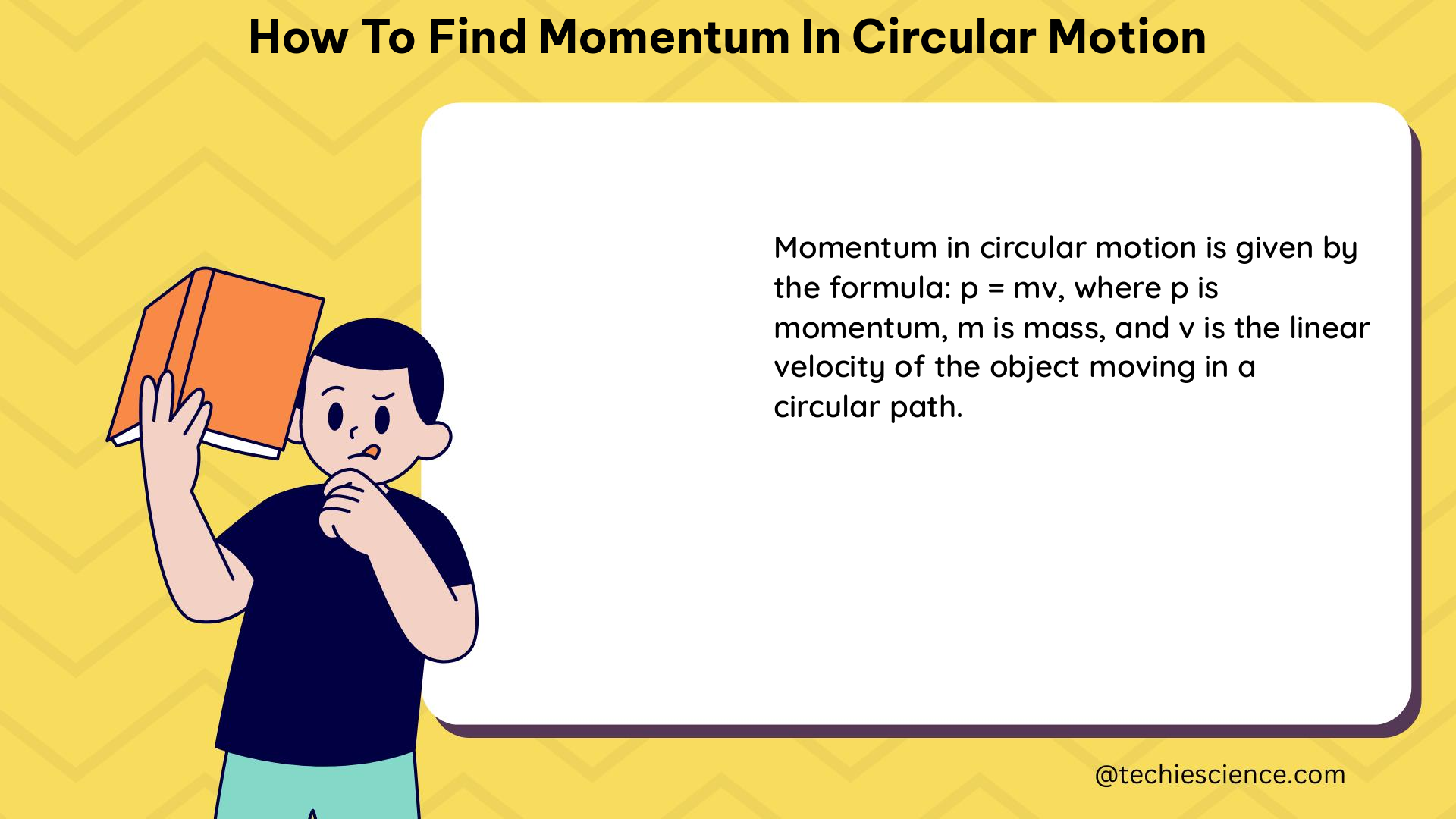In the realm of classical mechanics, understanding the concept of momentum in circular motion is crucial for physics students and enthusiasts alike. This comprehensive guide will delve into the intricacies of calculating angular momentum, a vector quantity that describes the rotational motion of an object. By mastering the formulas and principles presented here, you will be equipped with the knowledge to tackle a wide range of problems related to circular motion.
Angular Momentum Formula
The angular momentum (L) is calculated by multiplying the moment of inertia (I) by the angular velocity (ω):
L = I \omega
This formula serves as the foundation for understanding and calculating the angular momentum of an object in circular motion.
Moment of Inertia Formula

The moment of inertia (I) is a measure of an object’s resistance to changes in its rotational motion. It depends on the mass distribution of the object around the axis of rotation. For a circular object, the moment of inertia can be calculated as:
I = mr^2
where m is the mass of the object and r is the radius of the circle.
Angular Velocity Formula
The angular velocity (ω) is the rate of change of the object’s angular position, measured in radians per second. It can be calculated from the linear velocity (v) and the radius of the circle:
\omega = \frac{v}{r}
This formula allows you to determine the angular velocity of an object in circular motion, which is a crucial component in the calculation of angular momentum.
Example Calculation
Let’s consider a circular object with a mass of 2 kg and a radius of 0.5 m. If it rotates at a linear velocity of 10 m/s, we can calculate its angular momentum as follows:
-
Calculate the angular velocity:
math
\omega = \frac{v}{r} = \frac{10\,\text{m/s}}{0.5\,\text{m}} = 20\,\text{rad/s} -
Calculate the moment of inertia:
math
I = mr^2 = (2\,\text{kg})(0.5\,\text{m})^2 = 0.5\,\text{kg}\cdot\text{m}^2 -
Calculate the angular momentum:
math
L = I \omega = (0.5\,\text{kg}\cdot\text{m}^2)(20\,\text{rad/s}) = 10\,\text{kg}\cdot\text{m}^2/\text{s}
Units
The units for angular momentum are typically kg m²/s, where kg is the unit of mass, m is the unit of length, and s is the unit of time. This reflects the fact that angular momentum is a vector quantity, with both magnitude and direction.
Theorems and Principles
-
Conservation of Angular Momentum: In the absence of external torques, the total angular momentum of a system remains constant. This principle is crucial in understanding the behavior of rotating systems.
-
Rotational Kinetic Energy: The rotational kinetic energy of an object in circular motion is given by the formula:
math
K_\text{rot} = \frac{1}{2}I\omega^2
This formula allows you to calculate the energy associated with the rotational motion of an object. -
Centripetal Force: The force that keeps an object in circular motion is called the centripetal force. It is directed towards the center of the circle and is given by the formula:
math
F_\text{c} = \frac{mv^2}{r}
This force is responsible for the object’s circular motion and is a crucial factor in the calculation of angular momentum.
Physics Examples and Numerical Problems
- Example 1: A solid metal disk with a mass of 5 kg and a radius of 0.3 m is rotating at an angular velocity of 10 rad/s. Calculate the angular momentum of the disk.
Solution:
math
I = mr^2 = (5\,\text{kg})(0.3\,\text{m})^2 = 0.45\,\text{kg}\cdot\text{m}^2
math
L = I\omega = (0.45\,\text{kg}\cdot\text{m}^2)(10\,\text{rad/s}) = 4.5\,\text{kg}\cdot\text{m}^2/\text{s}
- Example 2: A satellite with a mass of 800 kg is orbiting the Earth in a circular path with a radius of 6000 km. If the satellite’s linear velocity is 7.5 km/s, calculate its angular momentum.
Solution:
math
\omega = \frac{v}{r} = \frac{7.5\,\text{km/s}}{6000\,\text{km}} = 0.00125\,\text{rad/s}
math
I = mr^2 = (800\,\text{kg})(6000\,\text{m})^2 = 2.88 \times 10^{11}\,\text{kg}\cdot\text{m}^2
math
L = I\omega = (2.88 \times 10^{11}\,\text{kg}\cdot\text{m}^2)(0.00125\,\text{rad/s}) = 3.6 \times 10^8\,\text{kg}\cdot\text{m}^2/\text{s}
- Numerical Problem: A uniform solid cylinder with a mass of 10 kg and a radius of 0.5 m is rotating at an angular velocity of 20 rad/s. Calculate the angular momentum of the cylinder.
Given:
– Mass (m) = 10 kg
– Radius (r) = 0.5 m
– Angular velocity (ω) = 20 rad/s
Step 1: Calculate the moment of inertia (I) of the cylinder.
math
I = mr^2 = (10\,\text{kg})(0.5\,\text{m})^2 = 1.25\,\text{kg}\cdot\text{m}^2
Step 2: Calculate the angular momentum (L) of the cylinder.
math
L = I\omega = (1.25\,\text{kg}\cdot\text{m}^2)(20\,\text{rad/s}) = 25\,\text{kg}\cdot\text{m}^2/\text{s}
Therefore, the angular momentum of the rotating solid cylinder is 25 kg·m²/s.
Figures and Data Points
To further illustrate the concepts of angular momentum in circular motion, consider the following figure and data points:
Data Points:
– Mass of the object: 2 kg
– Radius of the circular path: 0.75 m
– Linear velocity of the object: 12 m/s
– Angular velocity of the object: 16 rad/s
– Moment of inertia of the object: 1.125 kg·m²
– Angular momentum of the object: 18 kg·m²/s
These data points and the accompanying figure can help you visualize and better understand the relationships between the various quantities involved in calculating angular momentum in circular motion.
Reference:
- OpenStax University Physics Volume 1: Moment of Inertia and Rotational Kinetic Energy – https://openstax.org/books/university-physics-volume-1/pages/10-4-moment-of-inertia-and-rotational-kinetic-energy
- TutorChase: How do you calculate angular momentum in circular motion? – https://www.tutorchase.com/answers/a-level/physics/how-do-you-calculate-angular-momentum-in-circular-motion
- Physics LibreTexts: Angular Momentum In Two Dimensions – https://phys.libretexts.org/Bookshelves/Conceptual_Physics/Conceptual_Physics_%28Crowell%29/05:_Conservation_of_Angular_Momentum/5.01:_Angular_Momentum_In_Two_Dimensions

The lambdageeks.com Core SME Team is a group of experienced subject matter experts from diverse scientific and technical fields including Physics, Chemistry, Technology,Electronics & Electrical Engineering, Automotive, Mechanical Engineering. Our team collaborates to create high-quality, well-researched articles on a wide range of science and technology topics for the lambdageeks.com website.
All Our Senior SME are having more than 7 Years of experience in the respective fields . They are either Working Industry Professionals or assocaited With different Universities. Refer Our Authors Page to get to know About our Core SMEs.